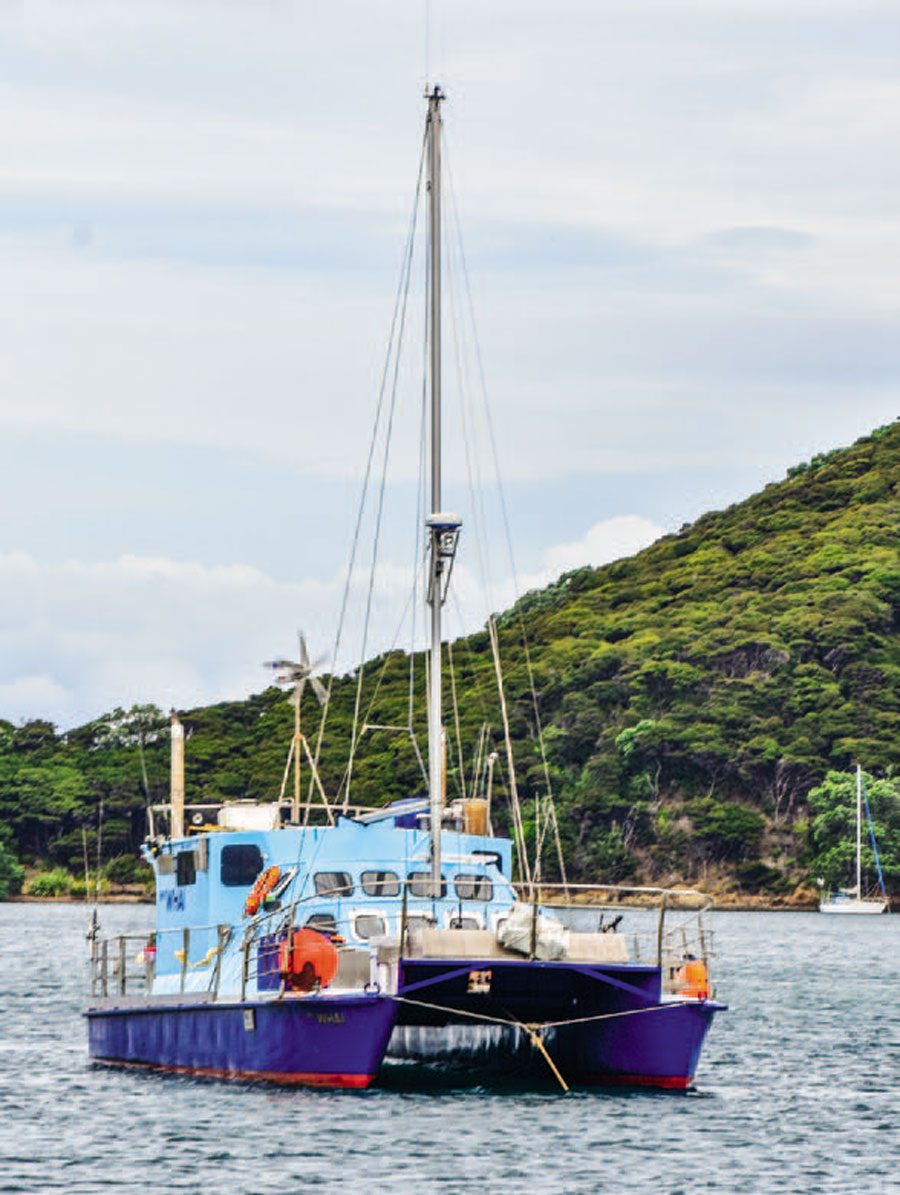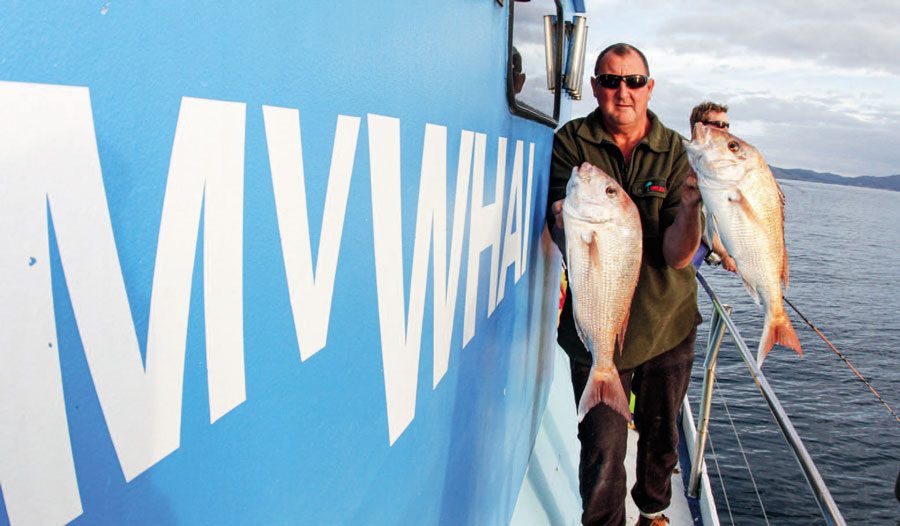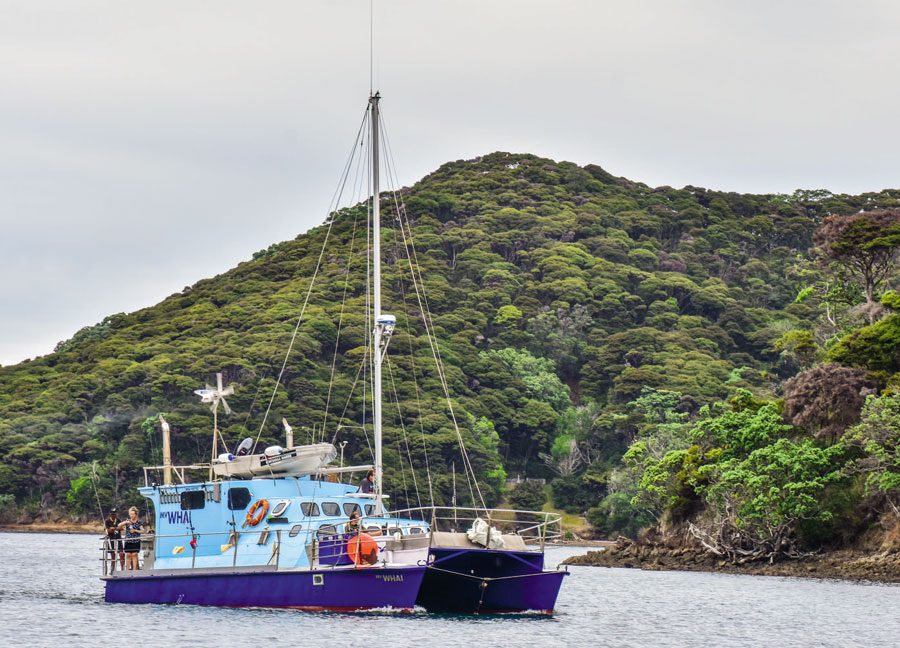

Fibreglass clone craft pop out of moulds all over Europe and the US on a daily basis, but there will only ever be one Whai.
“ Yeah,” says skipper John Ellwood affectionately, “she’s like your favourite old tractor, she just keeps going and going.”
Steaming into the bay on Aotea Great Barrier Island, MV (motor vessel) Whai looks like a floating World War 1 army tank, a Mk1 perhaps, squat and imperturbable.
But it was another war that played a key role in her construction in a Whanganui back yard. Locally born and raised WW2 fighter pilot Peter Spurdle had flown Warhawk (Kittyhawk) fighters for the US Air Force and strafed a Japanese gunboat fleet in the New Georgia Islands.
In 1965, 22 years later, he joined the crew of a ketch, Windswift, to return to the site of the attack to look for souvenirs. The yacht didn’t impress him at all. “For weeks now, the Windswift had been rolling along,” he wrote in his book Into the Rising Sun. “What I think and say about sailing craft would make a yachtie spit – but I don’t care – they’re all mad.”
“I like the rumble and beat of motors – they lull you to sleep. You get used to the noise and, after a few hours don’t hear them at all. With a motor vessel there is no need to huddle up wet and miserable in an open cockpit; rather a comfortable seat in front of a group of glittering gauges; the radio, the echo sounder, with compass and charts to hand. This, to me, is the way to travel.”
Spurdle opted for: “a power catamaran – two hulls for stability and two motors for reliability. And no sails – not one.”
Returning to New Zealand he began building Whai. First off, two steel cylinders were made. These were of 5mm-thick steel, 625mm in diameter and 5m long. Each was divided into two 562-litre fuel tanks and a 180-litre water tank.
These formed the keels and he laid them on wooden blocks, 3.9m apart and built the main body of the boat from them. First the bows and sterns were fabricated and added.
“I had no plans,” he explained, “just the length, beam and height that I judged sensible and in proportion” Two Ford 2701E industrial diesels were added with Paragon gearboxes but as the boat grew, available funds dwindled, so Spurdle “decided that the Whai would not be used as a toy boat – but as a tool – she would make the ideal charter boat,” he wrote.

And ensuing events would prove him dead right.
But first he would need to put the boat in Marine Department survey and the Spurdle vs bureaucrats battle began.
There was no problem building a 13.4m steel boat – the office wallahs could understand that – but from there it was all downhill.
The local marine surveyor in Whanganui referred him to head office in Wellington – where he was sent back to see the surveyor in Whanganui.
“They asked about plans… I told them I didn’t have any; I was building it out of my head… but they insisted that they’d need plans. And they wanted to see the steel work specifications to ensure they complied with regulations.”
Finally he was asked what kind of boat it was.
“The confession. The moment of truth,” he wrote, “ I told them: ‘It’s a catamaran.’”
“By the surveyor’s expression, it was like I’d used a four-letter word.”
Without plans or a precedent to work from, the Department flatly refused to issue a survey certificate.
After sketching up some plans on a sheet of paper, they granted a provisional certificate dependent on the result of sea trials.
 Whai is also about family. The Ellwoods and friends enjoy a summer cruise.
Whai is also about family. The Ellwoods and friends enjoy a summer cruise.
“And then THE IDEA was born,” he said. “I’d prove the Whai was sound – I’d do a big trip in it – more than just a trip to the islands, something spectacular; a real deep sea voyage after which they would have to accept the Whai.”
He decided to steam 14,000nm to Japan and back, the longest passage made by a small motor boat at the time and, being somewhat short of funds, recruited a crew of fellow scuba divers to share expenses.
All of 16 tonnes and 5.5m beam, Whai was launched into the Whanganui River by a tractor, a perilous operation before a large crowd of onlookers.
It was also the launching of a career spent giving people pleasure; over 50 people crowded on board for the launching party.
To take her offshore created a whole new raft of bureaucratic road blocks for Spurdle and the Whai. “The Marine Department doesn’t want to be blamed for incidents or accidents at sea – or get involved with amateur navigators, small craft and hairy enterprises,” he explained, “so they’ve struck a bargain with the larger yacht clubs to provide honorary inspectors to examine yachts and crews. However, because of the inordinate number of multi-hulled craft lost at sea over the years (or is it jealousy over their superior speed and comfort?) the conventional yachties have declined to survey multihulls.”
The solution was to approach the Multihull Association, but they turned him down on the basis that they only surveyed sailing vessels and knew nothing about engines.
But an unusually open-minded marine inspector agreed to perform the inspection and Whai was pulled out at Oram’s Boatyard for a going over.
“She wasn’t the largest – but certainly the widest they’d ever handled,” Spurdle recalled, “graceful yachts; white and immaculate, edged away as the black Whai was winched dripping from the muddy waters.
Finally, after several nights spent learning navigation – this was an age when navigation was a skill, not just a matter of turning a GPS receiver on – and having the compass deviation card complied, Whai was ready to go.

The crew called by Norfolk Island and on to New Caledonia where customs clearance created some linguistic challenges. “The customs officer couldn’t speak English – and my French could get me wine, women and song only.”
With a crew of keen divers on board, Whai motored to the Solomon Islands where they gleaned some keepsakes from military ordinance which had been dumped at sea after WW2.
A chapter of Into the Rising Sun covers their adventures and mishaps in Micronesia and again encountering would-be pirates off the Philippines.
There are accounts of fumbling their way into a Chinese naval engagement, surviving a cyclone, the warm and hospitable reception at Okinawa and their arrival, five months after leaving Whangarei, at Osaka in July, 1970.
After a few weeks rest and recreation, Whai headed back for New Zealand where she arrived eight and a half months after her departure. The doughty steel catamaran was rust-streaked and weather worn from her time at sea – but she’d admirably proved Spurdle’s point.
The Marine Department grudgingly signed off a survey certificate for the boat and Spurdle began doing fishing charters from Whitianga with her.
After a few years Whai was sold to keen Coromandel fishing folk, Mick and Dulcie Ellwood, who continued her charter work for over 25 years. Their son John had been running the boat since 2000 and, in 2004, he and his wife Ann bought her and have run her ever since.
 John Ellwood offers fishing charters to clients who come back year after year.
John Ellwood offers fishing charters to clients who come back year after year.
The original 120hp Ford diesels (100hp at 2,500rpm) had clocked up about 45,000 hours and were getting a bit long in the tooth, so in the mid 1980s they were replaced by 6BT Cummins (about 200hp).
“We also replaced the gearboxes and propellers – where we used to cruise at 6.2 knots with the Fords, we now do 7.2 knots – and one litre of fuel per nautical mile,” skipper John Ellwood said.
But Whai’s passage-making abilities haven’t been in abeyance either. Over the last few years, she has made regular winter trips to Fiji, Tonga, New Caledonia, and Vanuatu for spots of scuba diving and game fishing.
“We’ve just changed our survey to New Zealand coastal waters – I don’t think we’ll be going up to the islands much for a while,” he said. Whai is surveyed to host 10–16 people.
This year one of the Cummins was replaced by a new version – the third engine replacement for that side of the boat. “We get about 29–32,000 hours out of them before they start to burn a bit of oil and we replace them,” he added.
John is only the third owner and Whai must be one of the busiest charter boats in the country.
 Nothing flash, but comfortable and a good sea boat.
Nothing flash, but comfortable and a good sea boat.
“She’s just like a giant caravan on the water – nothing flash – all you have to do is to go out and have a good time. People can dump dive bottles and other heavy stuff on the deck without worrying about doing too much damage.”
“She’s just comfy.”
Over the years she’s had an extra 1.2m added to her overall length, some accommodation modifications and the aft deck covered over.
“We’re fortunate in having a good client base – we’re mostly booked up 10 years in advance. People come back year after year. It’s great, like catching up with family. We talk about what sort of year they’ve had and what they’ve been up to – it’s always interesting when you haven’t seen someone for a year.”
One diving groom proposed to his partner while they were underwater at Minerva Reef so Whai has become part of their family history.
“About 99% of our business is repeat clients – one group has been back for 49 years running on the Whai. She’s a great sea boat….oh, and there’s always the nice, easy-going skipper, (“No… no… don’t put that…”.). ” “ Some of our regular people are starting to die off, that’s the only free berths we get,” he added.
That may be true, people will come and go – but Whai will go on. Whai – to follow, pursue, track. BNZ




